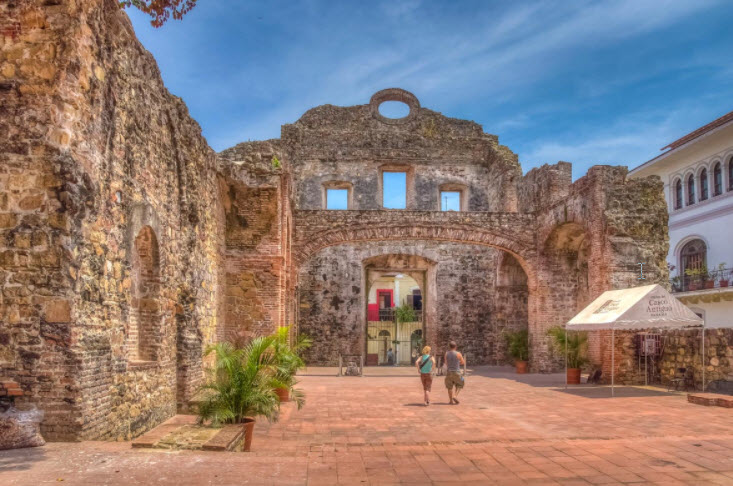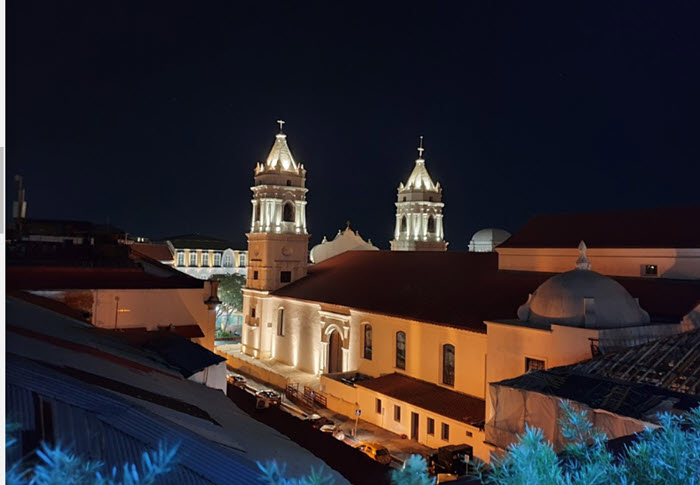Casco, my favorite part of Panama City.
Big waves roll onto flat sandy beaches, coffee plantations dot lush mountainsides, and turquoise-blue coves border tropical islands. It might come as a surprise to some travelers, but all of these scenes play out in Panama — the Central American country that has long been known mostly for its famous canal.
For me, Panama was a revelation in the best possible way. There’s no question that other Central American countries like Costa Rica and Belize get more tourism buzz. But when I got the opportunity to accompany a friend who was visiting her daughter serving in the Peace Corps in Panama, I jumped at the chance to experience a culture that would be new to me.
What I found was a delightful combination of abundant beaches, hidden waterfalls, seafood-focused cuisine, and fascinating history. Oh, and there’s also the 51-mile-long Panama Canal — a true marvel, and one of the seven modern wonders of the world.
There are so many things to love about this small country, and here are eight of the best.
1. Two Oceans In One Day
Because Panama is about 30 miles across at its narrowest point and 115 miles at its widest, you can easily take in its two coasts in one day, and if you prefer, in an hour or two. On the west and south side of the country, you have the Pacific Ocean, and on the north and east, the Caribbean Sea.
What is especially wonderful about the double-ocean scenario is that, despite their proximity, the two seas have completely different vibes. The Pacific side is all about wide, sandy beaches with waves tumbling toward shore. And the Caribbean side is everything you’d expect from a tropical paradise — white sand, aquamarine water, and swaying palm trees.
On the Pacific side, my traveling companions and I loved the Gulf of Chiriqui’s Las Lajas, a laid-back resort with miles of open beach, perfect for wave jumping and long walks. On the Caribbean side, there is Bocas del Toro, a mashup of lush rainforest, little islands, and the country’s most popular beaches.
The Visit Panama website describes the Pacific side as “hot winds, lush vegetation, lots of sun, and if you’re lucky, humpback whales.” On the Caribbean side, visitors can expect calmer waves, relaxing breezes, and hundreds of tropical islands.

2. The San Blas Islands
Speaking of tropical paradise, the San Blas Islands (which includes the indigenous province Guna Yala) seem to have written the book on the topic. The stunning string of islands certainly wowed me. San Blas — a territory of the Guna (or Kuna) indigenous group — is made up of a narrow strip of land on the Caribbean side of the country, along with an archipelago of 365 islands, only 50 of which are inhabited by the Guna people.
Before heading out on our three-day adventure to the remote landmass of Isla Diablo, we were cautioned that the accommodations would be rustic. And they were — featuring thatched huts, sand floors, and rudimentary toilets and showers. But with the powdery white sand and shimmering blue water spread before us, we hardly noticed.
Getting to the islands can be a bit of a feat, requiring a 2.5-hour drive from Panama City to Carti, the main port of the San Blas Islands. There, you will transfer to boats that will take you to the various island destinations. Our boat ride lasted nearly an hour through choppy waters.
Still, the trip is certainly doable for mature travelers, so visitors shouldn’t let the slight inconveniences deter them. We were at our little piece of paradise in time for a late lunch, and the stay turned out to be a highlight of my trip.
Note that varied accommodation types are available, including bungalows, sailboats, and catamarans. The VRBO website offers a variety of options and prices. The Visit Panama site suggests stopping off at El Porvenir, which is the capital of Guna Yala, or Isla Perro for amazing snorkeling.
Pro Tips
We made sure to stock up on a few basic conveniences before heading out to the islands, knowing that we wouldn’t have access to shops or convenience stores. Once in our little hut, we were glad that we had brought along snacks and a few drinks of choice. Also, visitors should be sure to wear sunscreen and a hat on the long, sunny boat rides between the islands.
3. Historic Casco Viejo
Dating back three and a half centuries, Panama’s old quarter, Casco Viejo (also known as Casco Antiguo), offers a glimpse into the days of gracious plazas and colonial-style architecture. The old quarter, designated a UNESCO Cultural World Heritage Site, was established in 1673 after the previous 1500s-era city center was attacked and looted by pirate Henry Morgan.
The best plan for exploring Casco Viejo is to wander the winding, brick-paved streets and take in the quaint courtyards, markets, and ruins. Along the way, be sure to stop by the Metropolitan Cathedral located on the main square, Plaza Mayor, and also take in the Church of San Jose, known for its golden altar. Another highlight is the Plaza de Francia, which pays homage to the French role in the construction of the Panama Canal.
Pro Tip
A trek through Casco Viejo should also include a stop or two at the restaurants and bars that are plentiful in the neighborhood. In my mind, there’s no better way to beat the tropical heat than to sit in an outdoor patio sipping a Balboa or Panama beer.

4. Cosmopolitan Panama City
The historic part of town is just a small section of the sprawling metropolis of Panama City. The rest of the city is definitely worth exploring for its diverse ethnic cuisine offerings, shining skyscrapers, and great shopping.
The Visit Panama website describes the capital city as three cities in one, with a historic district, a rebuilt district, and very modern areas. “As a UNESCO creative city for gastronomy, Panama City is home to a vibrant and diverse food scene, led by world-class chefs,” says the website. Along with the delicious and unique Panamanian food, virtually every ethnic cuisine seems to be available in Panama City as well.
5. Panama Canal
No visit to Panama would be complete without seeing its namesake canal — an engineering achievement that looms large in the country’s identity.
Like most Americans, much of my previous knowledge about Panama had come from school history lessons about the arduous task of digging the Panama Canal in the early 1900s, and decades later, about the handover of control of the canal from the United States to Panama.
I couldn’t wait to see the phenomenon in person, and visiting the canal from Panama City turned out to be fairly easy. The Miraflores Visitor Center, which offers viewing platforms, is a 15-minute drive from downtown Panama City, and the Agua Clara Locks are a 1-hour drive from the city. There is also the option of a boat-ride tour through the crossing itself.
Once at the canal, visitors will find a somewhat hectic scene, with ships from all over the world making the short-cut journey between the Pacific Ocean and the Caribbean Sea. I found it fascinating to watch the elaborate lock system lift massive ships up to the elevation of the canal.
6. The Ceviche
Another notable feature of Panama is its ample seafood, and perhaps no other dish brings it all together like ceviche, the delicious creation of marinated raw fish or seafood.
For a staggering assortment of ceviche types, head to Panama City’s Mercado de Mariscos, a busy fish market, where dozens of vendors peddle their versions of the Panamanian favorite. You will find vats of octopus, shrimp, and fish spiced up with lime juice, chile peppers, and cilantro. The casual booths serve their creations in cups alongside servings of thick tortilla chips or saltines. Outdoor tables are available for a seaside lunch.
7. Indigenous Art
Panama is home to six indigenous groups, and each of the cultures has an art style of its own.
The most well-known example of the artworks is the colorful mola, created by the Guna people. The meticulously stitched textiles are available for sale all over the San Blas Islands and at markets in Panama City. My advice is if you see one you like, buy it, because you likely won’t find the exact design again.
Other crafts, such as beaded jewelry, purses with geometric designs, and colorful blouses and dresses, can be found throughout the country.
Pro Tip
For a close-up look at the history of molas, head to the Museo de la Mola, which features the textile art of the Guna people. (Because of temporary COVID-19-related closures, be sure to check ahead for availability.)

8. Coffee Plantations
As if the gorgeous beaches and captivating history weren’t enough, Panama features another dimension, as well, in its rainforest-covered mountains, where coffee is the prominent crop.
The pretty little town of Boquete, located on the western end of Panama, not far from the border with Costa Rica, is the perfect base for exploring the coffee region. Choices for touring and sampling are numerous, but for a chance to shop, tour, and hike in a lushly beautiful atmosphere, I loved Finca Lerida, about a half-hour drive from Boquete.
Pro Tip
Typically, a number of major airlines, including United, Delta, and American, offer flights to Panama City’s main airport, Tocumen International Airport, with direct flights from cities such as Houston, Dallas, Los Angeles, Miami, and New York City. The airport’s website offers tips here for getting from the airport to the city center, located about a half-hour drive away.
Stay Safe!!

